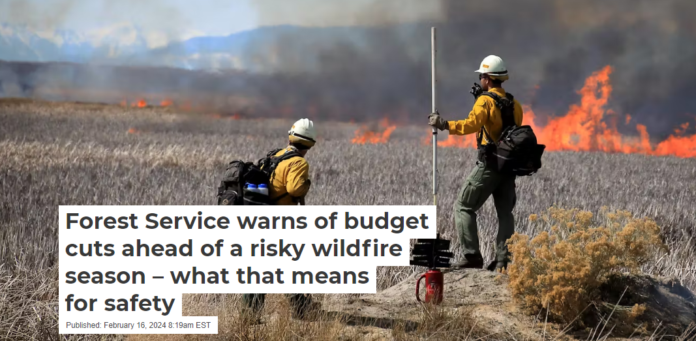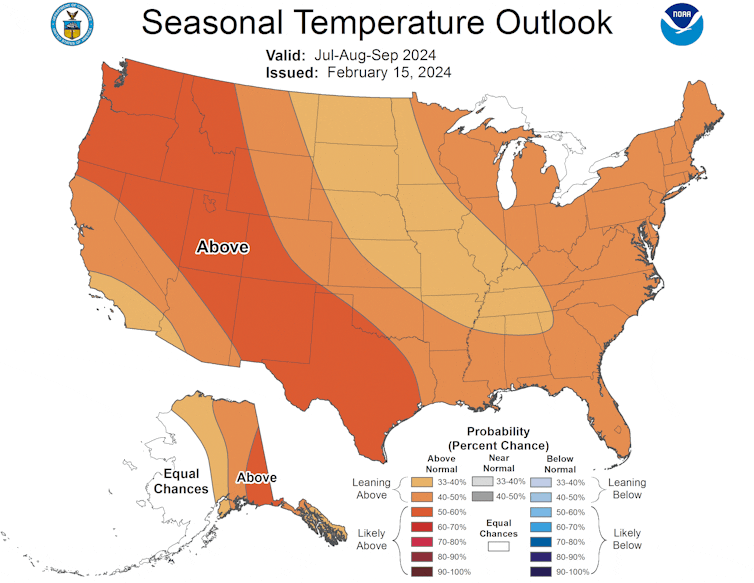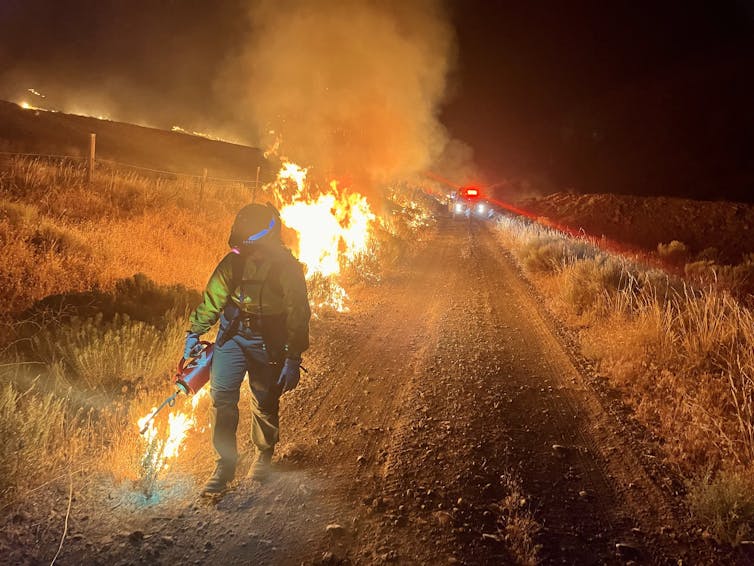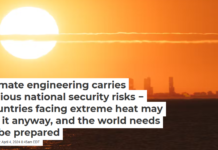

Camille Stevens-Rumann, Colorado State University and Jude Bayham, Colorado State University
A wet winter and spring followed by a hot, dry summer can be a dangerous combination in the Western U.S. The rain fuels bountiful vegetation growth, and when summer heat dries out that vegetation, it can leave grasses and shrubs ready to burn.
In years like this, controlled burns and prescribed fire treatments are crucial to help protect communities against wildfires. Well-staffed fire crews ready to respond to blazes are essential, too.

These are some of the reasons why an announcement from U.S. Forest Service Chief Randy Moore on Feb. 8, 2024, is raising concerns. Moore told agency employees to expect budget cuts from Congress in 2024. His letter was thin on details. However, taken at face value, budget cuts could be interpreted as a reduction in the firefighting workforce, compounding recruitment and retention challenges that the Forest Service is already facing.
So what does this mean for the coming fire season? We study wildfire policy and fire ecology, and one of us, Camille Stevens-Rumann, has worked as a wildland firefighter. Here are a few important things to know.
The fire funding fix
While Moore’s letter raises concerns, the financial reality for fighting fires this year is likely less dire than it might otherwise be for one key reason.
The 2018 Consolidated Appropriations Act included what is known as the “fire funding fix.” It introduced a new budget structure, creating a separate disaster fund accessible during costly wildfire seasons. The fire funding fix allows federal firefighting agencies to access up to US$2.25 billion in additional disaster funding a year starting in 2020 and increasing to $2.95 billion in 2027.
Prior to the fire funding fix, fighting fires – suppression expenditures – consumed nearly 50% of the U.S. Forest Service budget. As bad fire years worsened, that left less funding for the agency’s other services, including conducting fuel treatments, such as prescribed burns, to reduce the risk of wildfires spreading.
The fix protects agency budgets, ensuring that a high-cost fire season will not completely consume the budget, and that allows more funding for preventive efforts and all the other programs of the Forest Service.
Prevention is a rising priority
The Forest Service has also made fire prevention a higher priority in recent years.
In 2022, it released a Wildfire Crisis Strategy and Implementation Plan that included ramping up fuel treatments to reduce the potential for large uncontrollable fires, as the West had seen in previous years. It called for treating up to an additional 50 million acres over 10 years.
That work won’t be completed before the 2024 fire season, but fuel treatments will be underway. They include prescribed burning to remove dry grasses, twigs, logs and other fuels in a controlled way and the use of heavy equipment to thin dense forest areas and create fire breaks by removing trees and vegetation.

Prescribed burning must be done when conditions are safe to limit the potential for the fire to get out of control, usually in the spring and early summer. However, climate change is expected to shorten the prescribed burning window in the western U.S.
Staffing is still a concern
Doing this work requires staff, and the Forest Service’s challenges in recruiting and retaining qualified firefighters may hinder its ability to accomplish all of its objectives.
In 2023, over 18,000 people were employed as federal wildland firefighters. While the Forest Service and Department of the Interior have not specified precise staffing targets, Moore has mentioned that “some crews have roughly half the staff they need.”
A recent Government Accountability Office report found that low wages and poor work-life balance, among other challenges, were barriers commonly cited by federal firefighting employees. The government boosted firefighters’ pay in 2021, but that increase is set to expire unless Congress votes to make it permanent. So far, firefighters have kept the same level of pay each time Congress pushed back acting on the 2024 budget, but it’s a precarious position.
The agency has started many initiatives to recruit and retain permanent employees, but it is too early to assess the results. A recent study involving one of us, Jude Bayham, found that highly qualified firefighters were more likely to remain with the agency after active seasons, during which they earn more money.
Everyone has a role in fire protection
Even with optimal funding and staffing, the firefighting agencies cannot protect every area from wildfire. Some of the defensive work will have to be done by residents in high-risk areas.
Homeowners can reduce the fire risk to their own properties by following defensible space recommendations.
These include keeping flammable vegetation away from buildings and reducing other fire hazards such as wood shingles, flammable debris in yards and pine needles in gutters. People should also pay attention to burn bans and avoid risky activities, such as leaving campfires unattended, setting off fireworks and using equipment that can spark fires on hot, dry, windy days. https://www.youtube.com/embed/VusWu3Y4cgY?wmode=transparent&start=0 Clearing away dead trees and brush within 100 feet of homes can help reduce fire risk.
The federal government and states have increased funds to help people reduce wildfire hazards on their property. The Bipartisan Infrastructure Law of 2021 included millions of dollars to support fire prevention on state, tribal and private lands. Several states also have programs, such as Colorado’s Forest Restoration and Wildfire Risk Mitigation Grant Program to support community investment in wildfire mitigation.
Recent disastrous wildfire seasons have shown how important it is to manage the fire risk. Consistent funding is crucial, and homeowners can help by taking defensive action to reduce wildfire risk on their property.
Camille Stevens-Rumann, Associate Professor of Forest and Rangeland Stewardship, Colorado State University and Jude Bayham, Associate Professor of Agricultural and Resource Economics, Colorado State University
This article is republished from The Conversation under a Creative Commons license. Read the original article.



















